External Fields
Shear Flow
Shear flow applied to dispersions of (bio-)macromolecules affects microstructure order, induces new phases, and gives rise to instabilities. Various systems of anisotropic colloids (like platelets and rods), both in the fluid- and glassy- state, as well as red blood cells are of interest.
| Red Blood Cells under Flow
Rouleaux are the cylindrical structures that spontaneously form in our blood when there is no flow and which cause our blood to have a high yield stress. In order to understand the flow of our blood it is therefore of fundamental importance to characterize the build up and break up of these rouleaux. We investigate this effect using our home-build zero-velocity plane shear cell as well as using a fundamental physical-chemical approach to tune interactions. |
 A confocal video of red blood cells in shear flow, showing the off-pinching of two membrane-connected cells. |
| The Molecular Origin Underlying Shear Thinning of Polymers
To resolve the microscopic origin of the shear thinning mechanism in polymeric systems, we perform confocal microscopy under flow of F-actin of several tens of microns long. This allows to probe the time-resolved configuration of the polymer chains in full 3D. We find, for example, that shear thinning is accompanied by a layering of the chains in planes perpendicular to the vorticity direction [1].
|
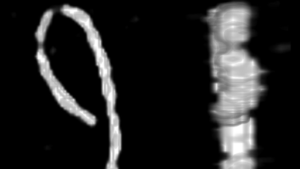 Time resolved confocal projections of fluorescence-labelled F-actin filaments from two different directions. The length of the shown F-actin is 20 micron. |
| Shearing Nematic Platelets
Most soft matter materials cannot be classified as fluids or solids because they possess a dual character: they can have a response that is solid-like or fluid-like, depending on the mechanical deformation. This dual, visco-elastic, character can also be found in an important class of soft matter systems, namely liquid crystals. Liquid crystals can be formed by small ‘colloidal’ platelets, such as clay particles, which all have similar orientation, so that they are in a nematic phase despite of their Brownian motion, which makes them colloidal. We subjected these dispersions of platelets to an oscillating shear field, squeezing the dispersions between two moving plates. By combining this geometry with x-ray scattering, we uncover the structural origin of the transformation between solid and liquid-like behaviour. These new insights might change the view on the origin of visco-elastic behaviour in complex fluids [2, 3]. |
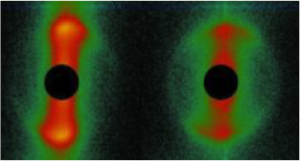 Movie shows scatter patterns of a nematic Gibbsite dispersion subjected to Large Oscillatory Shear taken throughout the gap of the shear cell. |
| Rods under Shear
Dispersions of colloidal rods can show very complex behavior under shear flow, depending on the concentration regime. While nematic as well as the dilute suspensions have received a lot of attention, the simple shear thinning response in the semidilute case is surprisingly neither well studied nor understood. In order to investigate the shear flow behavior of rods, filamentous bacteriophages are bio-engineered to create a library of model systems. By using rheo-SANS from two different directions, the 3D particle distributions can be evaluated under shear flow [4]. |
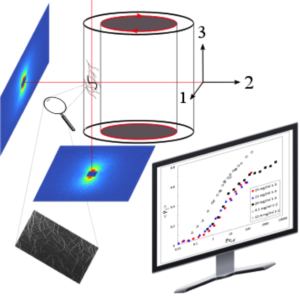 3D rheo-SANS of fd-wildtype, showing biaxial orientational ordering. |
| Non-uniform Flow of Glasses
Spatial gradients in the shear rate lead to mass transport, giving rise to non-uniform, banded flow profiles. This instability (the “Shear-gradient Concentration Coupling instability”) is especially relevant for colloidal systems with a yield stress, like glasses and gels. A microscopic theory is developed to explain the origin of the shear-gradient induced mass transport [1]. |
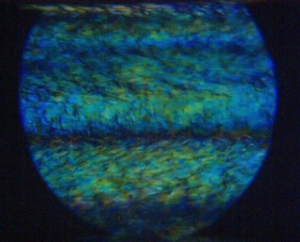 Vorticity banded state in a glass of rods. The height of this image is 2 cm.
|
Confinement
In the ultimate vicinity to confining walls, the interaction field of suspended colloidal particles is different from their bulk behaviour, and their dynamics is slowed down as compared to the bulk diffusion [1]. Besides their scientific interest, these effects are important in many technological, biological and bio-medical processes, like the motion of proteins in membranes, or the approach of a virus or a drug carrier to cells.
| Particle Wall Interactions
Using total internal reflection microscopy (TIRM) we can determine the interaction energy profiles between colloidal particles and flat wall with an unprecedented force resolution. Besides investigating theses energies in equilibrium suspension [2], we investigate how external fields like shear can be used to tune them. Typical examples are depletion forces induced by anisotropic particles, which can be suppressed by aligning the particles in a flow field [3]. |
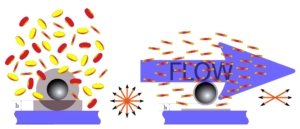 Suppression of depletion interaction caused by colloidal platelets due to shear flow. The range of the depletion forces is drastically reduced by alignment of the platelets in the flow field. |
| Near Wall Particle Dynamics
We study the effect of solid surfaces on colloidal dynamics by evanescent wave dynamic light scattering. In very dilute suspension of hard spheres, there is a pronounced slowing down of the particles dynamics close to the wall. When particle concentrations increase this effect becomes smaller [4] until it appears to vanish upon approach to the transition from the isotropic to an ordered colloidal state. In suspensions of particles with long ranging charge repulsion [5] the parity of bulk and near wall dynamics can occur at particle concentrations as low as seven per cent. |
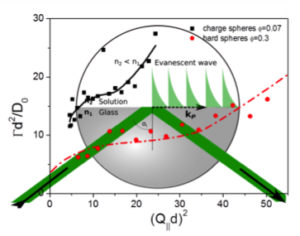 Near wall dynamics of colloidal hard spheres and colloidal spheres with long range charge repulsion, as determined by EWDLS. The dynamics of charged particles approach bulk values at much smaller volume fractions than the dynamics of hard sphere particles do. |
Temperature Gradients
Thermophoresis, also known as the Ludwig−Soret effect or thermodiffusion, is the migration of particles or molecules induced by a temperature gradient. It has been utilized to monitor biochemical reactions and to determine equilibrium constants, which are essential for the development of new pharmaceuticals. Thermophoresis is also discussed in the context of the origin of pre-biotic molecules. The microscopic mechanism of this effect is still not completely understood, especially in systems with hydrogen bonding.
| Thermodiffusion of Charged Colloids
We studied systematically the thermophoresis of spherical and rod-like charge colloids with a holographic grating technique. We could show, that the thermal diffusion coefficient of a charged colloidal rod is accurately represented, for arbitrary Debye lengths, by a superposition of spherical beads with the same diameter of the rod and the same surface charge density, which is in good agreement with electrophoresis measurements. |
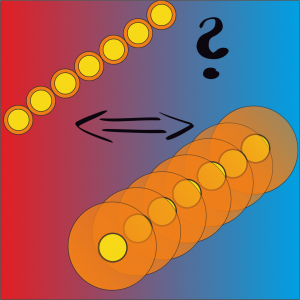 The thermophoretic mobility of a charged rod is essentially equal to the sum of mobilities of spherical colloids, for any value of the Debye length compared to the core-thickness. |
| The Early-earth Formation of Pre-biotic Molecules
We showed that prebiotic nucleobases can be formed in hydrothermal pores, through a significant accumulation of formamide resulting from a combination of thermophoresis and convection. Starting from typical low concentrations under early earth conditions formamide accumulates at the bottom of hydrothermal pores in about 45–90 days to high concentrated formamide solutions. The conclusion from these findings is that the combination of thermophoretic mass transport and convection is the missing link, which makes the synthesis of prebiotic nucleobases in porous rocks in contact with shallow lakes under early-earth conditions possible. As indicated in the animation, the formamide accumulates in the left lower corner of the pore. |
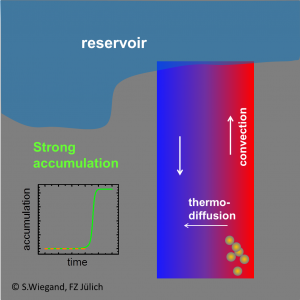 An animation illustrating the accumulation in hydrothermal pores, driven by a combination of thermodiffusion and convection. The plot shows the degree of accumulation as function of time. Click here for the movie |
| Understanding Protein-ligand Binding Using Simple Model Systems Molecular recognition via protein–ligand interactions is of fundamental importance to most processes occurring within living organisms. Structural fluctuations and conformational motions of proteins are essential for the binding of ligands and other interaction partners. It turns out that the thermophoresis is very sensitive to this binding event, but the cause is still unclear. Using cyclodextrins and their complexes with common drugs as a simple model system, which does not undergo conformational changes under complex formation, we found a clear correlation with the hydrophilicity. |
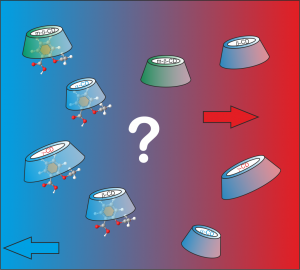 Influence of thermophoresis under complex formation. |
Electric Fields
Electric fields affect microstructural order of macromolecular suspensions, and can induce dynamical states and new phases. We are particularly interested in the response of charged macromolecules to low-frequency fields.
| Dielectric spectroscopy of microgel particles
We proposed a theory for the electric polarization due to mobile ions within the polymer network of PNIPAM microgel particles, as well as a theory for electrode polarization that is valid for all electric-field frequencies. Applying these theories to dielectric spectroscopy experiments allowed for the determination of the concentration dependence of the size, the net charge, as well as the degree of ion-association to the microgel PNIPAM polymer back-bone, which quantities are difficult to obtain by other methods. The dielectric spectrum reveals various polarization mechanisms, as shown in the figure: at low frequencies electrode polarization dominates, followed by the polarization relaxation due to mobile ions within the polymer network of the microgel particles, a relaxation due to the electric double layer surrounding the particles, and the polarization relaxation of the PNIPAM polymer network [1]. |
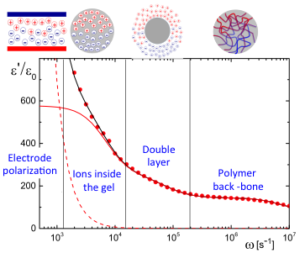 A dielectric spectrum, indicating the various relaxation mechanisms. The dotted line is the electrode-polarization contribution, the solid line the contribution from the microgel particles. |
|
Electric-field Induced Phases and Dynamical States Various phases and dynamical states are induced by low frequency electric fields in dispersions of very long and thin, highly charged colloidal rods (fd-viruses) [1]. These new phases and states are stabilized by field-induced interactions as well as the field-induced dissociation of condensed ions [2, 3]. In particular, there is a dynamical state (state D in the figure) where small nematic domains persistently melt and re-form. We identified a “non-equilibrium critical point” where a length scale and a time scale diverge, and measured by means of image-time correlation the corresponding critical exponents [4]. |
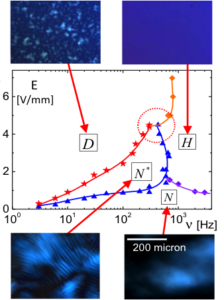 Various phase/state transition lines in the electric-field strength versus frequency plane. |
